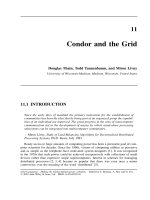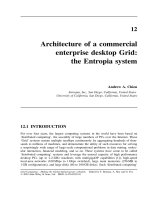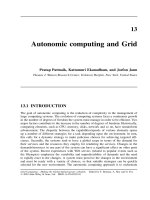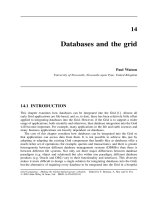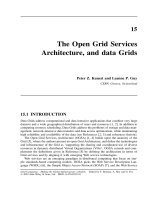Tài liệu Grid Computing P12 pptx
Bạn đang xem bản rút gọn của tài liệu. Xem và tải ngay bản đầy đủ của tài liệu tại đây (233.39 KB, 14 trang )
12
Architecture of a commercial
enterprise desktop Grid:
the Entropia system
Andrew A. Chien
Entropia, Inc., San Diego, California, United States
University of California, San Diego, California, United States
12.1 INTRODUCTION
For over four years, the largest computing systems in the world have been based on
‘distributed computing’, the assembly of large numbers of PCs over the Internet. These
‘Grid’ systems sustain multiple teraflops continuously by aggregating hundreds of thou-
sands to millions of machines, and demonstrate the utility of such resources for solving
a surprisingly wide range of large-scale computational problems in data mining, molec-
ular interaction, financial modeling, and so on. These systems have come to be called
‘distributed computing’ systems and leverage the unused capacity of high performance
desktop PCs (up to 2.2-GHz machines with multigigaOP capabilities [1]), high-speed
local-area networks (100 Mbps to 1 Gbps switched), large main memories (256 MB to
1 GB configurations), and large disks (60 to 100 GB disks). Such ‘distributed computing’
Grid Computing – Making the Global Infrastructure a Reality. Edited by F. Berman, A. Hey and G. Fox
2003 John Wiley & Sons, Ltd ISBN: 0-470-85319-0
338
ANDREW A. CHIEN
or desktop Grid systems leverage the installed hardware capability (and work well even
with much lower performance PCs), and thus can achieve a cost per unit computing (or
return-on-investment) superior to the cheapest hardware alternatives by as much as a fac-
tor of five or ten. As a result, distributed computing systems are now gaining increased
attention and adoption within the enterprises to solve their largest computing problems
and attack new problems of unprecedented scale. For the remainder of the chapter, we
focus on enterprise desktop Grid computing. We use the terms distributed computing, high
throughput computing,anddesktop Grids synonymously to refer to systems that tap vast
pools of desktop resources to solve large computing problems, both to meet deadlines or
to simply tap large quantities of resources.
For a number of years, a significant element of the research and now commercial
computing community has been working on technologies for Grids [2–6]. These systems
typically involve servers and desktops, and their fundamental defining feature is to share
resources in new ways. In our view, the Entropia system is a desktop Grid that can provide
massive quantities of resources and will naturally be integrated with server resources into
an enterprise Grid [7, 8].
While the tremendous computing resources available through distributed computing
present new opportunities, harnessing them in the enterprise is quite challenging. Because
distributed computing exploits existing resources, to acquire the most resources, capa-
ble systems must thrive in environments of extreme heterogeneity in machine hard-
ware and software configuration, network structure, and individual/network management
practice. The existing resources have naturally been installed and designed for pur-
poses other than distributed computing, (e.g. desktop word processing, web information
access, spreadsheets, etc.); the resources must be exploited without disturbing their pri-
mary use.
To achieve a high degree of utility, distributed computing must capture a large number
of valuable applications – it must be easy to put an application on the platform – and
secure the application and its data as it executes on the network. And of course, the
systems must support large numbers of resources, thousands to millions of computers,
to achieve their promise of tremendous power, and do so without requiring armies of IT
administrators.
The Entropia system provides solutions to the above desktop distributed comput-
ing challenges. The key advantages of the Entropia system are the ease of applica-
tion integration, and a new model for providing security and unobtrusiveness for the
application and client machine. Applications are integrated using binary modification
technology without requiring any changes to the source code. This binary integration
automatically ensures that the application is unobtrusive, and provides security and pro-
tection for both the client machine and the application’s data. This makes it easy to port
applications to the Entropia system. Other systems require developers to change their
source code to use custom Application Programming Interfaces (APIs) or simply pro-
vide weaker security and protection [9–11]. In many cases, application source code may
not be available, and recompiling and debugging with custom APIs can be a signifi-
cant effort.
ARCHITECTURE OF A COMMERCIAL ENTERPRISE DESKTOP GRID: THE ENTROPIA SYSTEM
339
The remainder of the chapter includes
•
an overview of the history of distributed computing (desktop Grids);
•
the key technical requirements for a desktop Grid platform: efficiency, robustness,
security, scalability, manageability, unobtrusiveness, and openness/ease of application
integration;
•
the Entropia system architecture, including its key elements and how it addresses the
key technical requirements;
•
a brief discussion of how applications are developed for the system; and
•
an example of how Entropia would be deployed in an enterprise IT environment.
12.2 BACKGROUND
The idea of distributed computing has been described and pursued as long as there have been
computers connected by networks. Early justifications of the ARPANET [12] described the
sharing of computational resources over the national network as a motivation for build-
ing the system. In the mid 1970s, the Ethernet was invented at Xerox PARC, providing
high-bandwidth local-area networking. This invention combined with the Alto Workstation
presented another opportunity for distributed computing, and the PARC Worm [13] was
the result. In the 1980s and early 1990s, several academic projects developed distributed
computing systems that supported one or several Unix systems [11, 14–17]. Of these, the
Condor Project is best known and most widely used. These early distributed computing
systems focused on developing efficient algorithms for scheduling [28], load balancing,
and fairness. However, these systems provided no special support for security and unobtru-
siveness, particularly in the case of misbehaving applications. Further, they do not manage
dynamic desktop environments, limit what is allowed in application execution, and have
significant per machine management effort.
In the mid-1980s, the parallel computing community began to leverage first Unix
workstations [18], and in the late 1990s, low-cost PC hardware [19, 20]. Clusters of
inexpensive PCs connected with high-speed interconnects were demonstrated to rival
supercomputers. While these systems focused on a different class of applications, tightly
coupled parallel, these systems provided clear evidence that PCs could deliver serious
computing power.
The growth of the Worldwide Web (WWW) [21] and exploding popularity of the Inter-
net created a new much larger scale opportunity for distributed computing. For the first
time, millions of desktop PCs were connected to wide-area networks both in the enter-
prise and in the home. The number of machines potentially accessible to an Internet-based
distributed computing system grew into the tens of millions of systems for the first time.
The scale of the resources (millions), the types of systems (windows PCs, laptops), and
the typical ownership (individuals, enterprises) and management (intermittent connection,
operation) gave rise to a new explosion of interest in a new set of technical challenges
for distributed computing.
340
ANDREW A. CHIEN
In 1996, Scott Kurowski partnered with George Woltman to begin a search for large
prime numbers, a task considered synonymous with the largest supercomputers. This
effort, the ‘Great Internet Mersenne Prime Search’ or GIMPS [22, 23], has been run-
ning continuously for more than five years with more than 200 000 machines, and has
discovered the 35th, 36th, 37th, 38th, and 39th Mersenne primes – the largest known
prime numbers. The most recent was discovered in November 2001 and is more than
4 million digits.
The GIMPS project was the first project taken on by Entropia, Inc., a startup commer-
cializing distributed computing. Another group, distributed.net [24], pursued a number of
cryptography-related distributed computing projects in this period as well. In 1999, the
best-known Internet distributed computing project SETI@home [25] began and rapidly
grew to several million machines (typically about 0.5 million active). These early Internet
distributed computing systems showed that aggregation of very large scale resources was
possible and that the resulting system dwarfed the resources of any single supercomputer,
at least for a certain class of applications. But these projects were single-application
systems, difficult to program and deploy, and very sensitive to the communication-to-
computation ratio. A simple programming error could cause network links to be saturated
and servers to be overloaded.
The current generation of distributed computing systems, a number of which are
commercial ventures, provide the capability to run multiple applications on a collection
of desktop and server computing resources [9, 10, 26, 27]. These systems are evolving
towards a general-use compute platform. As such, providing tools for application integra-
tion and robust execution are the focus of these systems.
Grid technologies developed in the research community [2, 3] have focused on issues
of security, interoperation, scheduling, communication, and storage. In all cases, these
efforts have been focused on Unix servers. For example, the vast majority if not all Globus
and Legion activity has been done on Unix servers. Such systems differ significantly from
Entropia, as they do not address issues that arise in a desktop environment, including
dynamic naming, intermittent connection, untrusted users, and so on. Further, they do
not address a range of challenges unique to the Windows environment, whose five major
variants are the predominant desktop operating system.
12.3 REQUIREMENTS FOR DISTRIBUTED
COMPUTING
Desktop Grid systems begin with a collection of computing resources, heterogeneous
in hardware and software configuration, distributed throughout a corporate network and
subject to varied management, and use regimens and aggregate them into an easily man-
ageable and usable single resource. Furthermore, a desktop Grid system must do this in a
fashion that ensures that there is little or no detectable impact on the use of the comput-
ing resources for other purposes. For end users of distributed computing, the aggregated
resources must be presented as a simple to use, robust resource. On the basis of our
experience with corporate end users, the following requirements are essential for a viable
enterprise desktop Grid solution:
ARCHITECTURE OF A COMMERCIAL ENTERPRISE DESKTOP GRID: THE ENTROPIA SYSTEM
341
Efficiency: The system harvests virtually all the idle resources available. The Entropia
system gathers over 95% of the desktop cycles unused by desktop user applications.
Robustness: Computational jobs must be completed with predictable performance, mask-
ing underlying resource failures.
Security: The system must protect the integrity of the distributed computation (tampering
with or disclosure of the application data and program must be prevented). In addition, the
desktop Grid system must protect the integrity of the desktops, preventing applications
from accessing or modifying desktop data.
Scalability: Desktop Grids must scale to the 1000s, 10 000s, and even 100 000s of desk-
top PCs deployed in enterprise networks. Systems must scale both upward and down-
ward – performing well with reasonable effort at a variety of system scales.
Manageability: With thousands to hundreds of thousands of computing resources, man-
agement and administration effort in a desktop Grid cannot scale up with the number of
resources. Desktop Grid systems must achieve manageability that requires no incremental
human effort as clients are added to the system. A crucial element is that the desktop
Grid cannot increase the basic desktop management effort.
Unobtrusiveness: Desktop Grids share resources (computing, storage, and network
resources) with other usage in the corporate IT environment. The desktop Grid’s use
of these resources should be unobtrusive, so as not to interfere with the primary use of
desktops by their primary owners and networks by other activities.
Openness/Ease of Application Integration: Desktop Grid software is a platform that sup-
ports applications, which in turn provide value to the end users. Distributed computing
systems must support applications developed with varied programming languages, models,
and tools – all with minimal development effort.
Together, we believe these seven criteria represent the key requirements for distributed
computing systems.
12.4 ENTROPIA SYSTEM ARCHITECTURE
The Entropia system addresses the seven key requirements by aggregating the raw desktop
resources into a single logical resource. The aggregate resource is reliable, secure, and
predictable, despite the fact that the underlying raw resources are unreliable (machines
may be turned off or rebooted), insecure (untrusted users may have electronic and physi-
cal access to machines), and unpredictable (machines may be heavily used by the desktop
user at any time). The logical resource provides high performance for applications through
parallelism while always respecting the desktop user and his or her use of the desktop
machine. Furthermore, the single logical resource can be managed from a single admin-
istrative console. Addition or removal of desktop machines is easily achieved, providing
a simple mechanism to scale the system as the organization grows or as the need for
computational cycles grows.
To support a large number of applications, and to support them securely, we employ
a proprietary binary sandboxing technique that enables any Win32 application to be
deployed in the Entropia system without modification and without any special system





